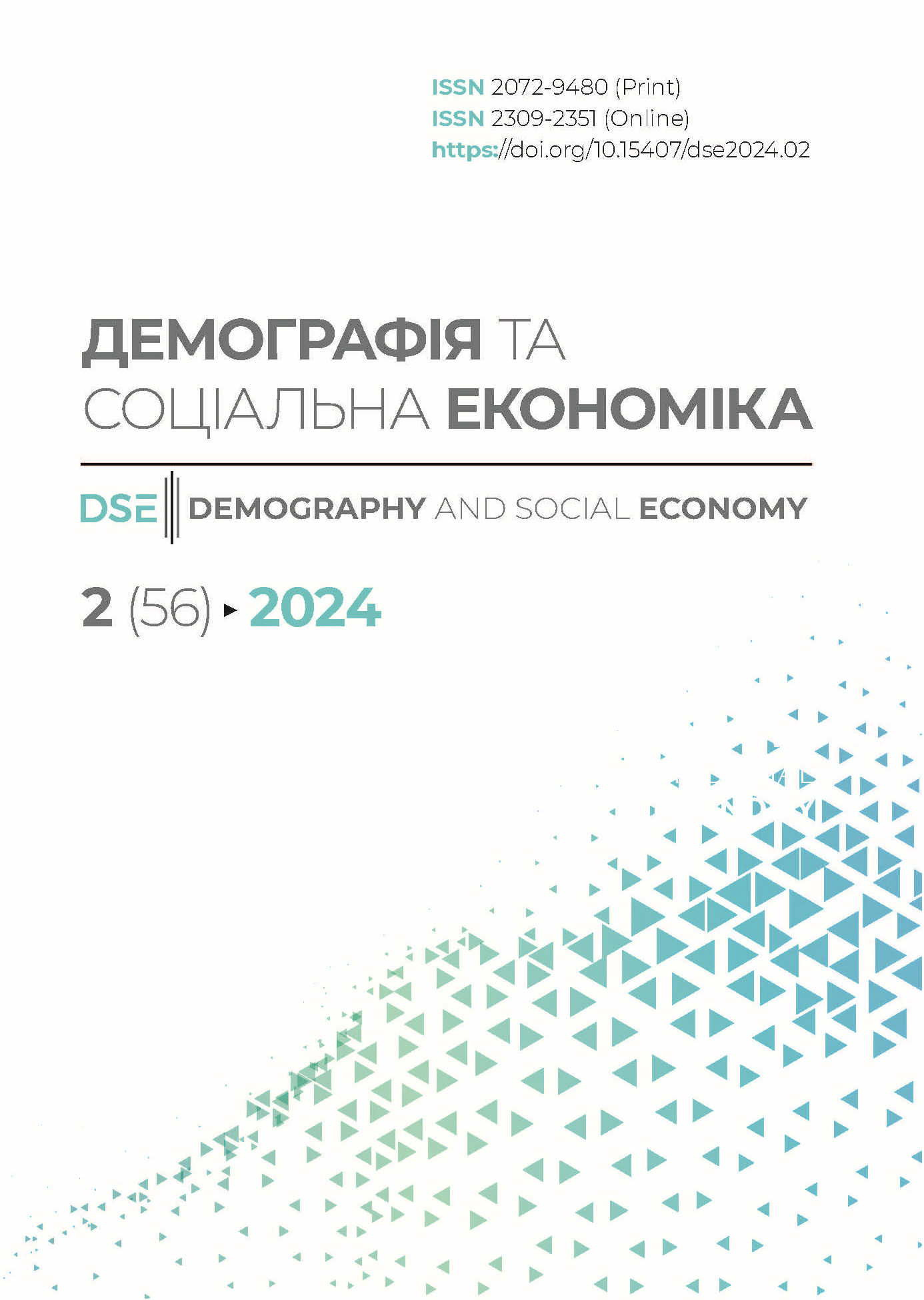CURRENT TRENDS OF HUMAN CAPITAL DEVELOPMENT IN THE GLOBAL ENVIRONMENT
DOI:
https://doi.org/10.15407/dse2024.02.025Keywords:
human development, Human Development Index, transnationalization, international migration, global cities, global governanceAbstract
The world’s development currently reflects the influence of globalization processes affecting the world economy, international relations, and human development. Therefore, it is relevant to study changes in human development under the impact of the growing interconnectedness and interdependence of the world. The objective of this article is to determine the impact of global processes on human development, as reflected by the global HDI. The novelty of the article is that it reveals trends in the development of human capital in a global environment under the influence of transnationalization processes, rising international migration, and the growth of global cities. The research relies on the methods of system analysis, scientific generalizations and comparisons, as well as economic and statistical analysis. The article postulates that multinational companies, which have spread in the process of globalization, contributed to the creation of millions of jobs throughout the world, stimulated the demand for highly qualified specialists and the rapid growth of all types of education, and promoted the introduction of new forms of production organization and control enhancing production culture and management. This caused the growth of employees’ incomes, boosted demand for consumer goods, thus stimulating a significant expansion of the range of supplied goods and services, the growth of national production and domestic market, and, finally, enhancing living standards and HDI indicators of the host countries. The rising importance of global demographic trends embraces a noticeable growth of the Earth’s population, which is uneven by country and region, the growth in the percentage of elderly people, especially in the developed countries. An important trend is the growth of international migration resulting from the liberalization of international relations, the development of communications, access to better education, the growth of well-being and expanding opportunities for education and self-realization abroad. The number of international migrants is growing faster than the global population, and this trend is likely to continue in the future. Urbanization and the growth of global cities have a significant impact on human development due to their high rates of employment, highly skilled labor, high professional and cultural level of workers, and high incomes. Such cities have become centers accumulating creative and intellectual capitals. The article exposes that investments in education, welfare, and health care in many countries had a positive long-term (over 30 consecutive years) effect on the growing values of the Human Development Index, as well as the global HDI, although the COVID-19 pandemic disrupted it in 2020. Meanwhile, HDI changes occur differently in different country groups, with OECD countries permanently holding the leading positions. The research adds new qualitative knowledge about human capital, trends in its development in the new conditions of globalization, which strengthens traditional views and enriches alternative approaches to the formation of conceptual understanding of human capital.
REFERENCES
- Libanova, E. M. (Ed.) (2016). Human Development in Ukraine. Innovative types of employment and their development prospects. Kyiv: Ptoukha Institute for Demography and Social Studies, NAS Ukraine [in Ukrainian].
- Libanova, E. (2024). Ukraine’s Plans for Demographic Recovery. Kennan Cable, No. 88. https://www.wilsoncenter.org/sites/default/files/media/uploads/documents/Kennan Cable_88.pdf
- Zayats, Т. (2021). Values Guidelines for Innovative Development in Ukraine. Demography and Social Economy, 2 (44), 3—21. https://doi.org/10.15407/dse2021.02.003 [in Ukrainian].
- Djakons, R., & Lukianenko, D. (Eds) (2020). Intellectual Challenges to Economic Globalism. Riga. https://ir.kneu.edu.ua:443/handle/2010/33572
- Kalenuk, I. S., & Kuznetsova, N. B. (2020). Human Capital Development in the Conditions of Creative Economy. Central Ukrainian Economic Bulletin. Economic Sciences, № 4(37), 77—85. https://doi.org/10.32515/2663-1636.2020.4(37) [in Ukrainian].
- Kolot, А. М., & Herasimenko, О. О. (2021). Labour XXI: the philosophy of change, challenges, and vectors of development: a monography. Ministry of Education and Science of Ukraine, Kyiv National Economic University named after Vadym Hetman. https://ir.kneu.edu.ua:443/handle/2010/36870 [in Ukrainian].
- Siskos, E., & Rogach, O. (2020). Internationalization of the World Economy: Current Trends. Kastoria: Evkonomia.
- The most innovative companies of 2023 — ranking (2023). https://news.finance.ua/ua/ nayinnovaciynishi–kompanii–2023–roku-reytynh–infohrafika [in Ukrainian].
- Statistical Update 2018: Human Development Indices and Indicators (2018). UNDP. New York. https://hdr.undp.org/system/files/documents/2018humandevelopmentstatisti calupdate.pdf
- Pensions at Glance 2021: OECD and G20 Indicators (2021). OECD. OECD Publishing. Paris. https://doi.org/10.1787/ca401ebd-en
- McAuliffe, M., & Triandafyllidou, A. (Eds) (2021). World Migration Report 2022. International Organization for Migration (IOM). Geneva. https://doi.org/10.1002/wom3.25
- Global Cities Index 2023 (2023). https://www.kearney.com/service/global-businesspolicy-council/gcr/2023-full-report
- Human Development Report 2021—22: Uncertain Times, Unsettled Lives: Shaping our Future in a Transforming World (2022). UNDP. New York.
- Sidenko, S. (2022). Priorities and Factors of Innovation Policy: Experience of Some East Asian Countries and Strategic Imperatives for the Post-War Reconstruction of Ukraine. Economy of Ukraine, 11 (732), 47—75. https://doi.org/10.15407/economyukr.2022.11.047 [in Ukrainian].
- Sidenko, S. (2023). Globalization, scientific and technological progress, and structural changes in the world economy. In: I. Y. Yegorov and Y. V. Kinzerski (Еds). The evaluation of innovative development and structural transformations in Ukraine’s economy. NAS of Ukraine, Institute for Economics and Forecasting. Kyiv. http://ief.org.ua/wp-content/ uploads/2023/08/Otsinka-innovatsijnoho-rozvytku.pdf https://doi.org/10.15407/econforecast2023.01.005 [in Ukrainian].
- Stiglitz, Joseph E. (2002). Globalization and its discontents. New York — London: W. W. Norton & Company.
- UN General Assembly. Seventieth Session. Transforming our world: the 2030 Agenda for Sustainable Development, 18 September 2015. A/70/L.1 (2023). https://documentsdds-ny.un.org/doc/UNDOC/LTD/N15/285/73/pdf/N1528573.pdf?OpenElement
- Sustainable Development Goals (2023). United Nations. https://www.un.org/en/academicimpact/page/sustainable-development-goals
- Human Development Reports Data Center. Human Development Index (2023). https:// hdr.undp.org/data-center/human-development-index#/indicies/HDI
- 2021 GDP per capita in current USD (2023). https://smartfin.ua/blog/minimalna-zarplatav-evropi-v-2021-rotsi [in Ukrainian].
- Human Development Report 2019 (2019). Beyond income, beyond averages, beyond today: Inequalities in human development in the 21st century. UNDP. New York. https:// hdr.undp.org/content/human-development-report-2019
- Zandt, Florian (2023). Which Countries Are Hitting the United Nations Development Aid Target? Statista, Sep. 5. https://www.statista.com/chart/8958/oecd-countries-oda-to-gni/
- What is resilience and how to operationalize it? (2023). OECD. https://www.oecd.org/ dac/conflict-fragility-resilience/risk–resilience/#:~:text=Understanding%20 resilience&text=Resilience%20is%20about%20addressing%20the,with%20risks%2C%20 stresses%20and%20shocks
Downloads
Published
How to Cite
Issue
Section
License
Copyright (c) 2024 Світлана Сіденко

This work is licensed under a Creative Commons Attribution-NonCommercial-NoDerivatives 4.0 International License.


